Rickshaw Day 13 - Guwahati to Shillong
Day 13.
Rain fell as Team Catan awoke in their comfortable quarters at the DBI. Mario took a run in the downpour. Martin took Benny, Christian, and Charly to the train station to witness the plight of local homeless kids. Katja and I missed the early departure when we got lost in DBI’s maze-like stairwells and passages. We got a long-overdue chance to get to know one another. Since it would be Team Catan's last road day with rickshaws, it was a timely chat.
Once everyone got back, we ate, repacked, and donned orange t-shirts. Then came time for us to go down to our rickshaws. The rain abated in time for our departure. There, the students gathered for photos, autographs, more speeches and a big farewell. Benny placed a pair of fluffy Catan dice around Johnson’s shoulders. I did the same with Martin.
[gallery]
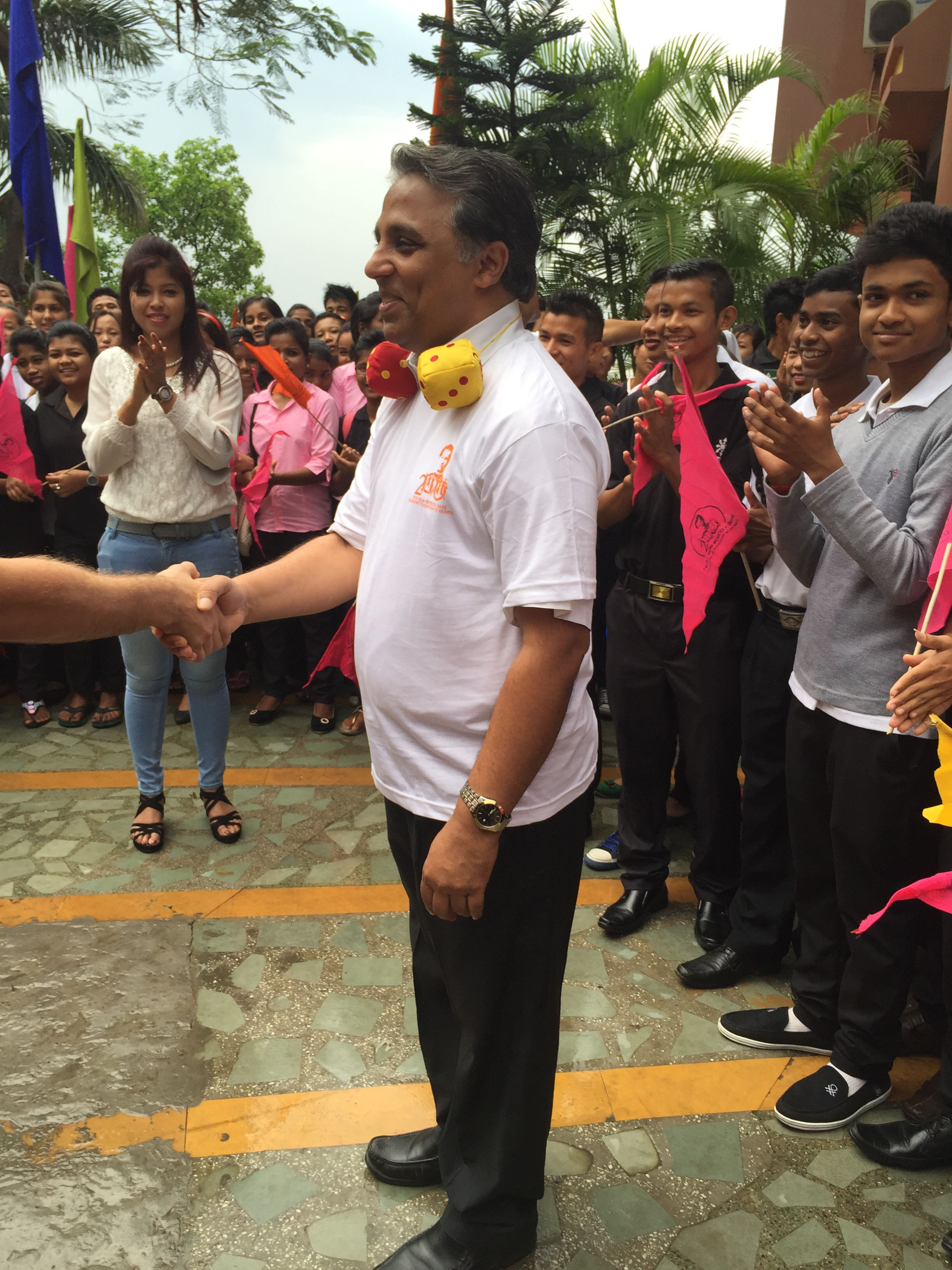
![file]
As the red, white, and blue rickshaws set off with a motorcycle escort through the streets of Guwahati, the rain picked up again. Bihu over and a market day beginning, Guwahati was awash with traffic. Our trio of rickshaws followed the motorbikes toward center city, where we turned into a narrow gateway tunnel that led to the courtyard of Guwahati’s huge, multi-balcony Don Bosco High School. Some 2600 kids awaited us, yelling and waving from each of the school’s four levels. Team Catan drove in circles around the wide, paved courtyard to great applause.
After we ascended the stage and sat like visiting royalty, young girls approached us and, one-by-one, placed yet another traditional red and white Assamese scarf around each crew member's neck. Festivities ensued with band and song performances. Here, we heard our first choir. It was another show of beauty, talent, love, and pageantry. Once again overwhelmed with thanks and joy, we waved and bid goodbye. Team Catan exited via the tunnel, picked up some motorcycle guides, and drove southward through the city. Our escort waved and broke away at the city’s edge.
[gallery]
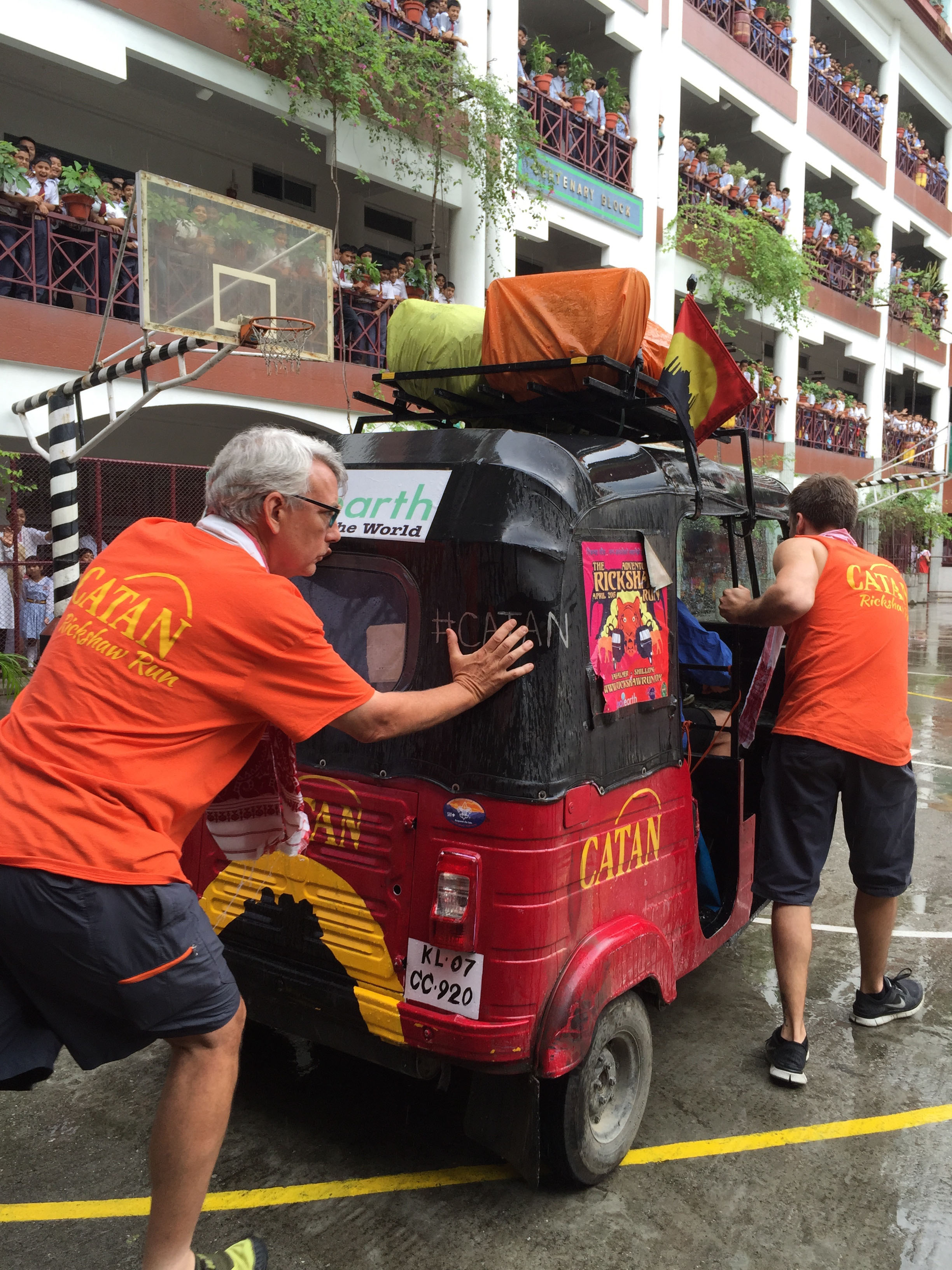
![file]
We now ascended into the hills south of Guwahati. The road wound up, down, and further up again as we left Assam and entered the highland state of Meghalaya. Here, the roughly 2000 meter ascent would test our rickshaws more than ever. The way up required good pacing and longer, more frequent engine rests.
Olivia and I had the easiest challenge, for the white rickshaw carried but two passengers. Our gearing was more forgiving and I could jump to fourth for much longer stretches. The grade affected each driver and rickshaw differently, making it hard to stay in order and keep regular spacing. We’d drive 50 km before we got the rhythm down.
In the meantime, we encountered 8-10 of our fellow rickshawers. Our only gas stop brought reunions and plenty of road tale exchanges. We could all feel that the finish line was but a few rests away. As we left the petrol station in a phalanx, a road party began. The weaving dance inspired photos, videos, and handshakes for most of the up and down drive toward Shillong.
In time, the road split and we found ourselves in the incredibly scenic highland lake country that gives Shillong its nickname as the “Scotland of the East.” We even stopped at a scenic overlook, where Team Catan’s women all chatted with a trio of young guys rooted in local lore and Hindu history. One was from Nagaland and confirmed the power and preeminence of that state’s legendary pepper.
[gallery]
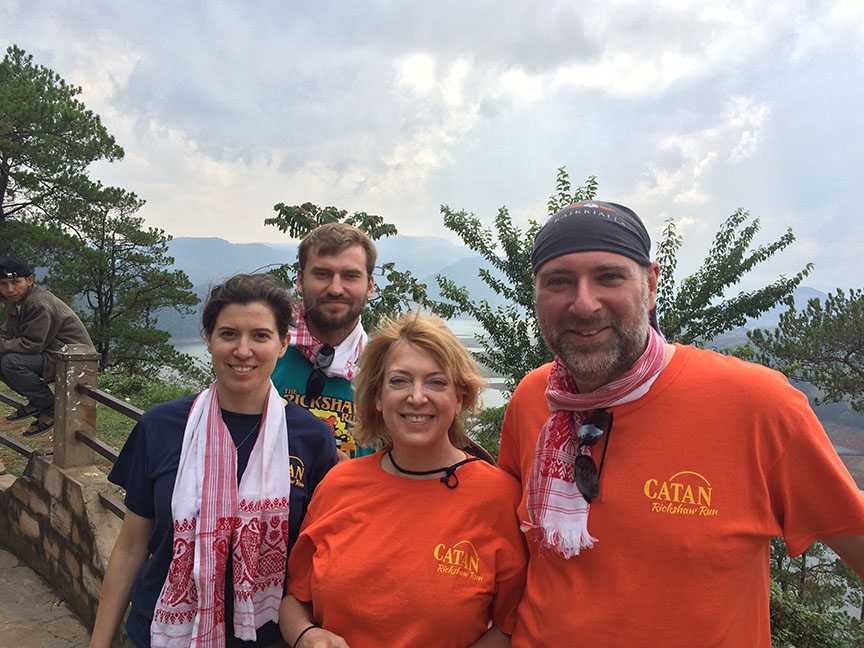
![file]
.
Shillong covered the hilltops some 100 km south of Guwahati. It had been a favorite British colonial retreat. Now it was a boomtown. The mix of tourism and coal mining created an odd juxtaposition of haves and have-nots. Poverty stood out starkly in its crowded, winding streets and stifling back alleys.
We of course arrived on market day. Since the locals had skipped recent market days, the influx of people and vehicles was especially choking. Team Catan inched up the lanes, often in our rarely-used first gear. The plan was to find the Hotel Barbareek, rendezvous with Ron and Cathy, check in, drop gear, clean up, and then proceed to the finish line. Given the hotel’s tight and obscure alley location by a stinking, rotting, vegetable dump, we spent a lot of time parking and shuttling gear.
Ron and Cathy were nowhere to be seen, nor was the orange rickshaw. Part of the mystery was immediately solved when two guys from the local Don Bosco school arrived to collect the hauling fee for transporting the rickshaw up from Kokrahjar via Guwahati. We paid them and instructed them to haul the rickshaw down to the finish line at the polo stadium. They claimed that they could also transport Cathy and Ron, who were purportedly at the school. (In fact, our two compadres were asleep elsewhere in the hotel!)
The long, drizzly drive from the hotel to the finish line took us through one of the great traffic jams in world history. The congestion, coupled with the fact that no one could locate the hidden finish line, created a slapstick adventure. Other lost rickshaws joined us. It took us an hour to negotiate a couple of km and find our appointed goal in a parking lot adjoining the stadium. We drove up to the finish line with three rickshaws around 5:00 pm.
Rather than crossing the elevated line, though, we elected to park and await the arrival of Cathy, Ron, and their orange rickshaw. Team Catan began turning in their documents and filling out forms just to get a jump on closure. Before we were finished with bureaucratic niceties and darkness began to fall, the DBI truck bearing the orange rickshaw showed. Matt and the Adventurists crew assisted us in gathering about a dozen rickshawers and lifting our rickshaw right off the truck’s flat bed.
No sooner had we gotten the orange rickshaw down, then Cathy and Ron arrived. They told us that we had missed them at the hotel!
Given the fact that their rickshaw was wounded, we gave Cathy the honor of crossing the finish first. She and Ron drove over the dais in triumph. Olivia and I followed. Then game Katja, Arnd, and Christian. Charly, Mario, and Benny served cleanup. Team Catan was done! We had driven our four rickshaws over 3000 km in support of the Childaid Network and introduced our brand to India in a novel, positive way. It was time to celebrate!
[gallery]
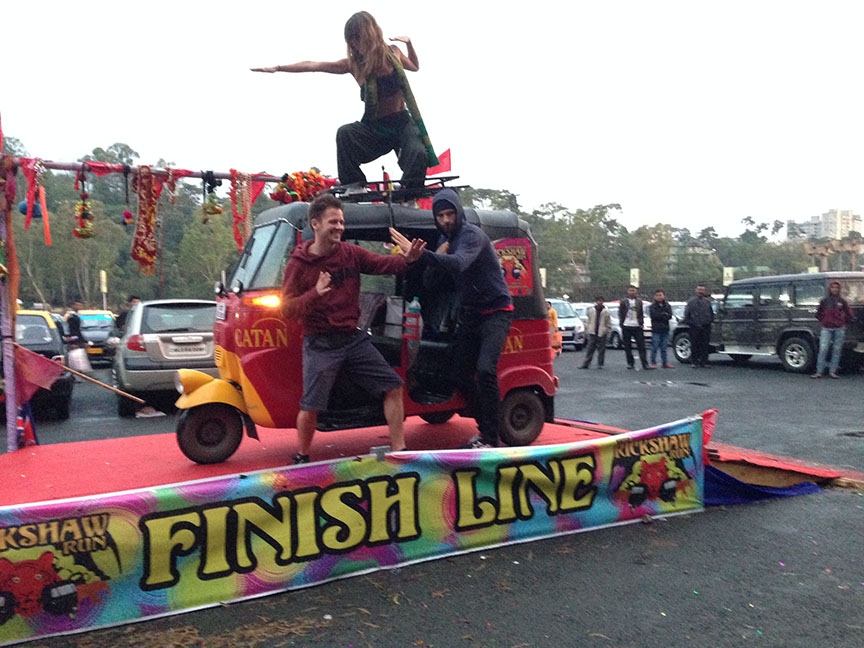
![file]
As we piled onto the buses to head off to the Adventurists’ big Rickshaw Party, Mario and Benny got off to help Charly find her purse. The rest of us missed the memo. Later we would discover that Charly’s purse had been stolen. All of her credit cards, money, and camera stuff were gone. Priceless images had disappeared with the theft and Charly faced a rough police investigation, followed by a difficult 3-day exit out of India. Apparently, one of the roving sports fans existing the stadium had nicked her purse. She was rightfully crushed.
Nonetheless, Charly, Mario, and Benny joined us the party, where there was music, awards, dancing, food, and a bar. Sadly, our beer vouchers only entitled us to lukewarm Buds. Happily, the local rockabilly band really knew their licks. All of us very festive rickshawers had a blast. Matt hosted a hilarious awards ceremony highlighted by the funny tale of our fellow rickshawers blundering into our parade and ceremony in Boko (see my last blog entry). Cathy won a flagon award for surviving her driving accident and gave a great speech. Charly won a photo award. All of us laughed, drank, and (to varying degrees) danced. It was a fitting celebration.
[gallery]
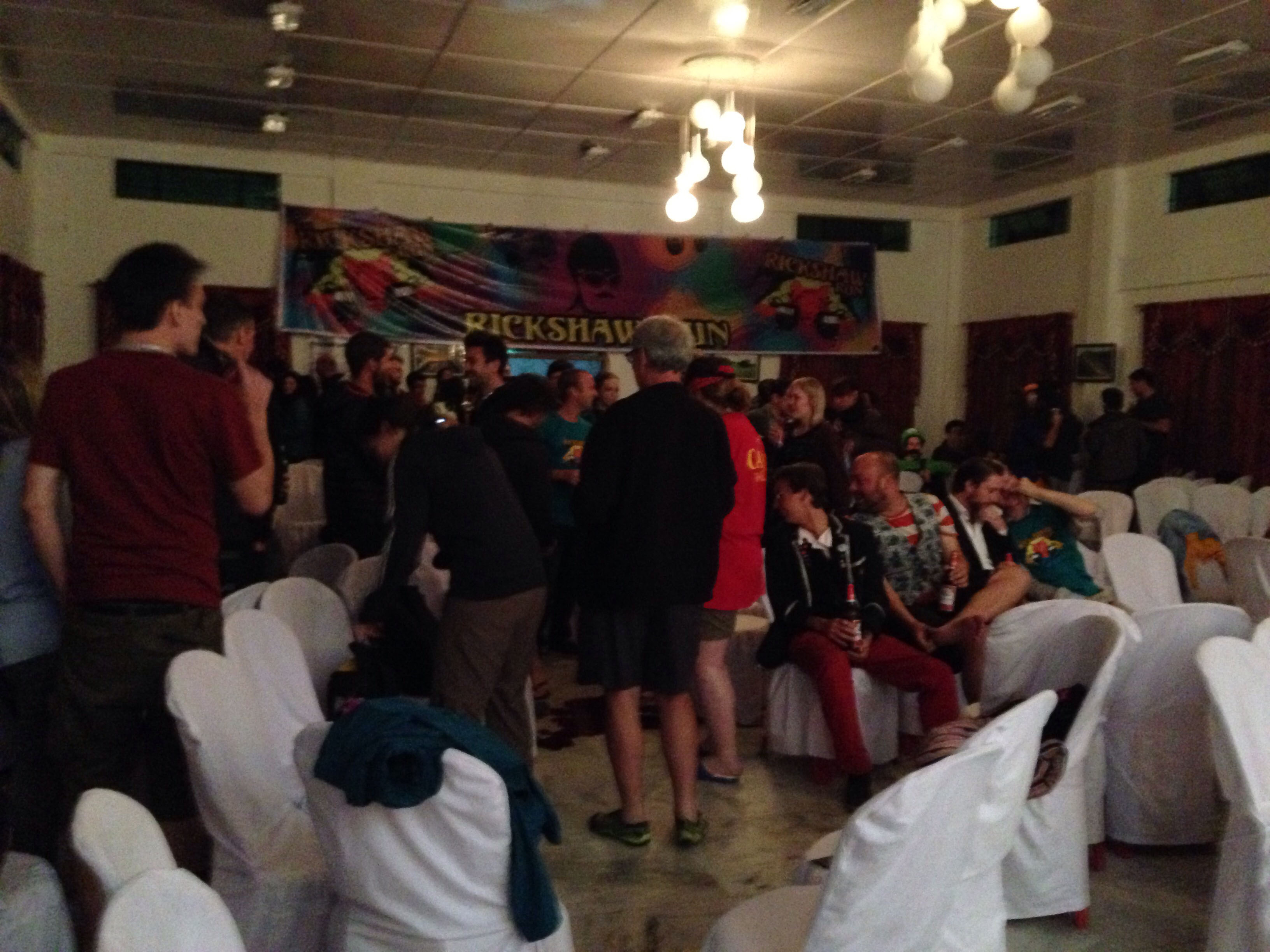
![file]
Team Catan hugged and toasted our collective victory as early as the finish line. So, as the party wore on, we felt comfortable enough to leave in two groups. Charly, Ron, and Cathy stayed through last call. All of us ultimately returned to the Hotel Barbareek in the dark rain and had to make big noise in order for the hoteliers to come down and let us in. Besieged by a dirty, tough neighborhood and lacking any doorbell, the hotel challenged us with one last obstacle before we could all find our triumphant resting place. It was oddly fitting, for everything about the Rickshaw Run was infused with adventure. Nothing came easy. But hard victory brought sweet joy.
Rickshaw Day 12 - Kokrajhar to Guwahati
Day 12.
It was another light blue ("Seafarers") t-shirt day.
As Team Catan rose early in Kokrajhar, Assam, we were missing four crew mates. Charly had woken well before dawn to strike off on her own quest to ride Asian elephants. Our team wanted to see her dreamed fulfilled, and Johnson’s driver made it happen. Charly was on her way eastward, where she would meet elephants and explore temples. Unlike Olivia, Cathy, Ron, and I, our six European teammates had been unable to tour the Jain temples of Jaisalmer.
Ron and Cathy would also set off on their own, this time in quest of Assamese tea. Meanwhile, the orange rickshaw had developed steering problems late the previous day, so we sent it ahead to Shillong on a truck. Cathy and Ron would reunite with it in time to finish our great rickshaw run, but this day they’d be buying tea for the team. Katja accompanied them on the morning leg.
After a wonderful sendoff from Father Damian and the Don Bosco High School kids, six of us took the blue, red, and white rickshaws over a rolling, scenic back road toward the Brahmaputra Bridge and Goalpata. A security escort led the way. Team Catan drove through small, bamboo-built villages and past brightly-painted plantation-style homes. Crossing rickety wood bridges, we encountered very little traffic but bicycles. It seems that bikes replace motorcycles as a principal mode of travel in India’s great Northeast. It’s in keeping with the cooler, cleaner, quieter, and richer vibe of Assam’s Brahmaputra Valley.
[gallery]
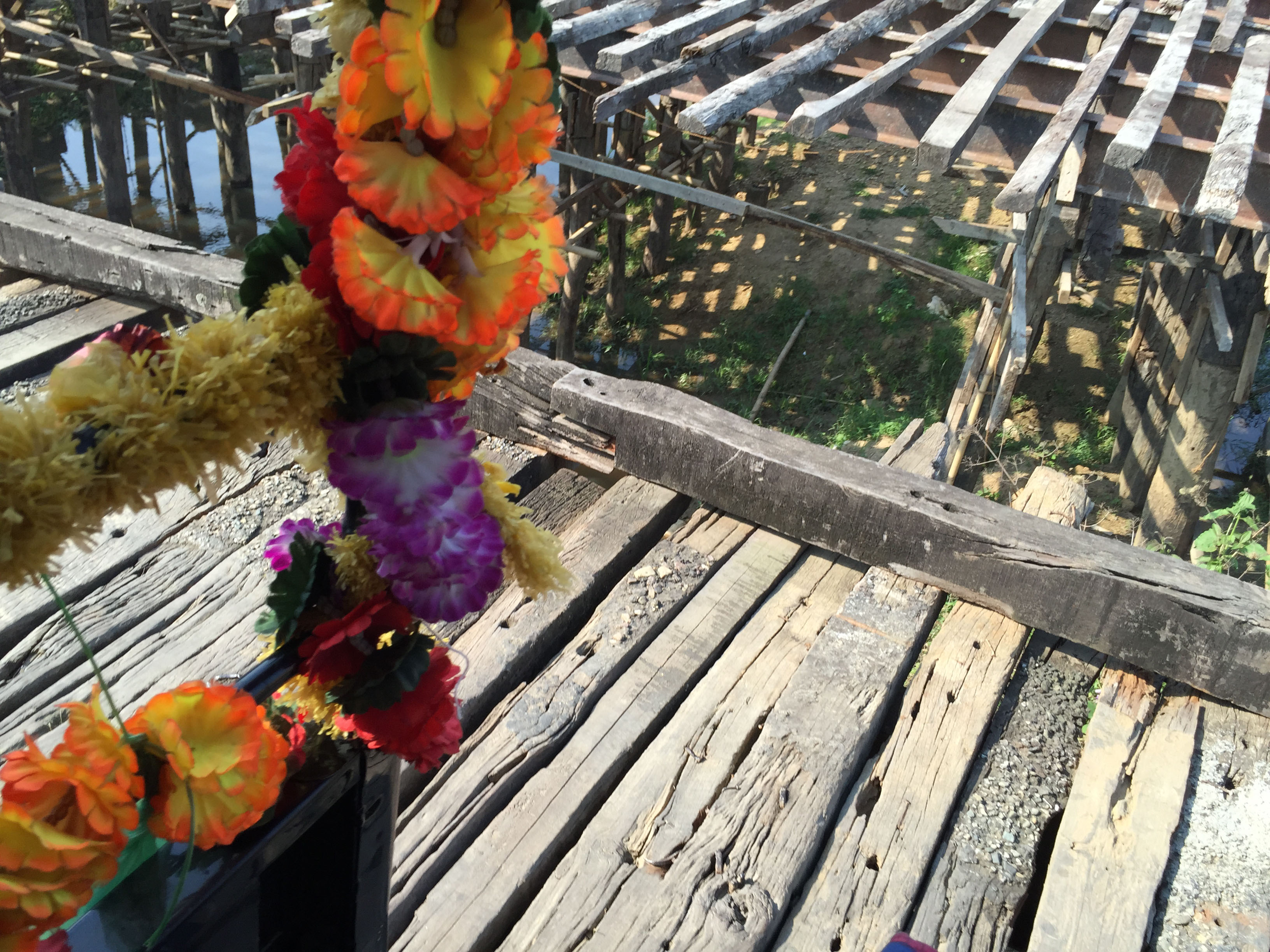
![file]
Soon after we hit the main road, we met up with Katja, Cathy, and Ron. Katja joined the blue rickshaw. Cathy and Ron continued tea quest. They would meet us at the next school gathering, which was in Goalpata. Team Catan then set off (sans security) across the very long Brahmaputra Bridge. We were told it was the first crossing downstream from the Guwahati Bridge, some 300 km upstream (to the east). A fierce wind buffeted the rickshaws as we road southward over the beautiful, bumpy span.
.
As we approached Goalpata, we picked up a different security team and a welcome parade of pennant-bearing bicycles and motorcycles. Martin and Johnson had mustered another school celebration for Team Catan, this one consisting of hundreds of kids. Again, we were feted with music, dance, and charming words of welcome. By now, many speakers simply referred to us as the “Catans.”
Young girls placed traditional Assamese scarves around our necks and the festivities began with a marching band. Struck once again by the beauty, talent, love, and pageantry, our team savored a great end to a very special morning. Then we waved goodbye and drove east toward Boko, a large market town bearing the same name as the local majority tribe. An escort led us out of Goalpata.
After passing a number of villages, all built on elevated ground and connected to the main road by dirt causeways or delicate wooden bridges, we came upon another assembly of smiling 2-wheeled escorts. They led us into Boko.
Cathy and Ron briefly reunited with us at the Boko school, but they had a faraway appointment. It was only later that they’d tell us that a group of our fellow rickshawers had preceded us and been mistaken for Team Catan. The 1600 school kids had started the marching band and begun their ceremonial hello before realizing that there were other rickshaws driving the Assamese roads that day. Confused, our fellow rickshawers had enjoyed the escort and music and driven to the school. Their donned hats before discovering the nature of the peculiar welcome. (This event would later strike the Adventurists as the funnest moment of the Rickshaw Run.)
Festivities in Boko resembled those of Goalpata, but on a larger scale. We received more scarves. Music, dance performances, and speeches followed. Benny spoke on Team Catan’s behalf.
[gallery]
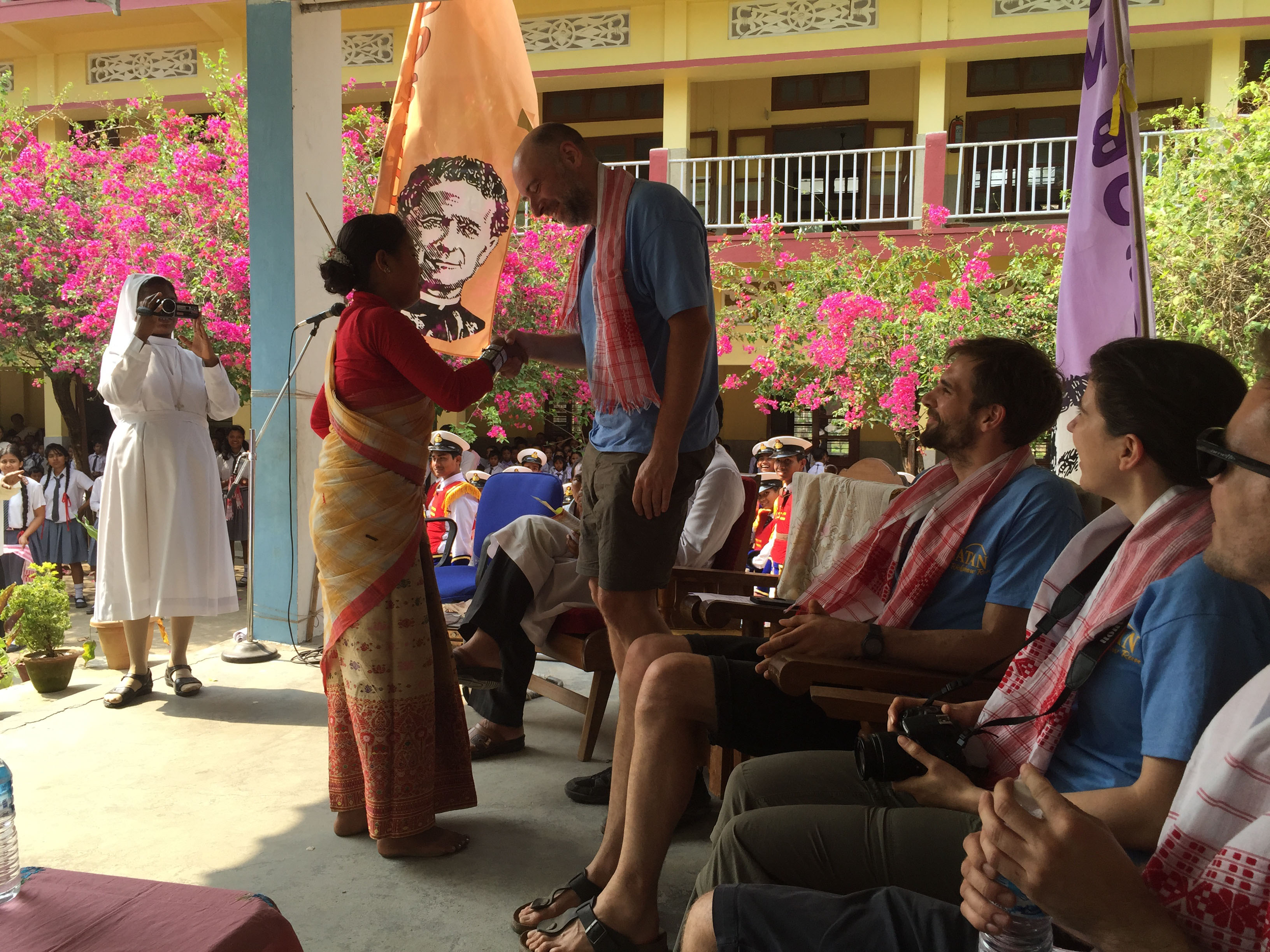
![file]
Our crew then broke toward the rickshaws through a sea of handshakes, pictures, and smiles. Mario rode a bike to great delight. As with the dancing the prior night, he continued to be our best ambassador to the Assamese kids. We then bid an emotional farewell. Team Catan continued eastward on 37 toward Guwahati. Our route paralleled the course of the wide Brahmaputra. We drove upstream some 70 more kms before reaching the edge of Guwahati, Assam’s chief city.
Guwahati is strung along the south bank of the Brahmaputra for about 20 km. Here, hills come down close to the river and islands punctuate the winding waters. Team Catan passed the airport, then the Guwahati Bridge, then downtown. We took a break at the ferry crossing for pictures of a beautiful sunset.
As darkness fell we entered the steep uphill drive into the multi-tiered Din Bosco Institute (DBI). There, Charly, Cathy, and Ron awaited us. So too did the orange rickshaw, which sat in the bed of a flatbed truck. It would leave for Shillong the next day.
Johnson was DBI’s current director. He had explained that we had become part of their 200th Anniversary celebration.
Once we negotiated the many floors, halls, and balconies that form the DBI’s fanciful HQ, we set up in rooms and cleaned up for the night’s festivities. This was to be the biggest and most elaborate of our many welcome parties.
We met at the institute’s great amphitheater. A graceful and enthusiastic Pinky, a DBI alum, served as master of ceremonies. She kept the crowd of students, student teachers, and faculty focused and stirred. Numerous tribal-based song and dance acts followed. All reflected the diversity and beauty of NE India. Groups from all over Assam, Arunachal Pradesh, Nagaland, and Meghalaya performed. The kids simply blew us away. Speeches followed. Benny and I both offered thanks and spoke of the Team Catan mission before the grand finale.
[gallery]
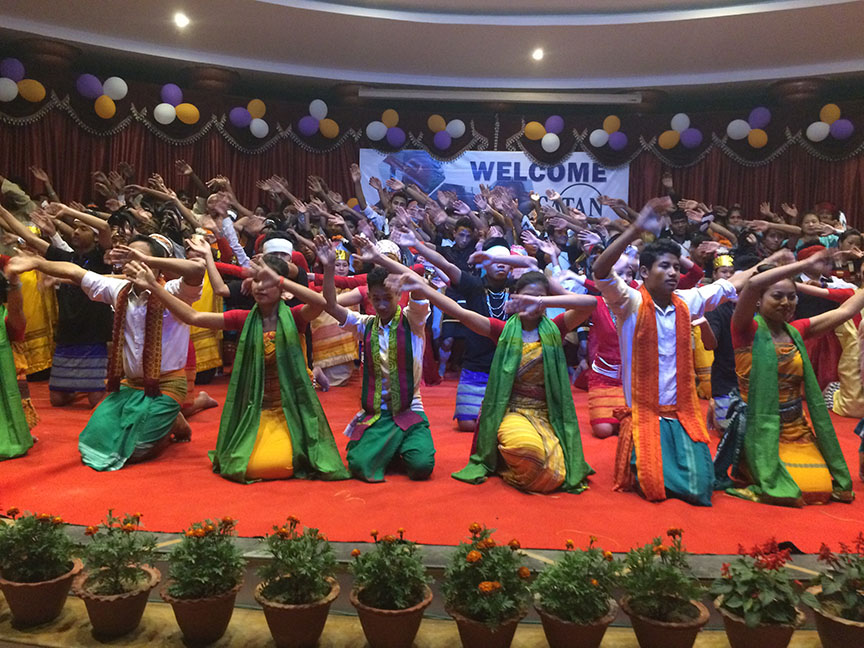
![file]
Then we retired upstairs for a buffet dinner. There, all of the rest of Team Catan issued their own thankful and moving words. Again, Team Catan had found a distant but welcoming home.
Rickshaw Day 11 - Siliguri to Kokrajhar
Day 11.
Team Catan awoke early on the final day of the 3-day Bengali/Assamese New Years called Bihu. It was to be an auspicious journey to Kokrajhar in Assam.
Red, with its new rebuilt clutch, led as we departed in our red t-shirts. Martin Kasper of Childaid Network and Father Johnson of the Don Bosco Institute bid us farewell and set off ahead in a Bolero (Tata’s SUV). They would photograph us on the road and lay a welcome mat after we reached Assam.
We got on the road around 0530 and had the luxury of light traffic as we headed northward in the direction of Sikkim. Our rickshaws sounded happy in the cool morning. We soon found ourselves back at the nature preserve we knew so well from the prior day’s breakdown. It was good to push past the point where red’s clutch blew out.
After climbing some foothills and winding through forests and tea gardens, we reached a big fork. The left way took you to Darjeeling and Sikkim. We went right across a bridge that spanned a mountain gorge. Tigers guarded the bridge, which led the way east to Assam.
[gallery]

![file]
Monkeys scurried about as we reached the far side.
[gallery]

![file]
The northeastern-most part of West Bengal is punctuated by tea plantations, tiger reserves, elephant reserves, and rhino habitats. Villages are tidy and even sturdy, as if the Raj had constructed them for cool Summer retreats. There are some signs of colonialism and tourism, but it’s still pretty remote. Here, we were very close to both Bhutan to the north and Bangladesh to the south.
[gallery]

![file]
We made great time. This was good, for we had miscalculated our distances a bit. In fact, we would drive 300+ km to Kokrajhar and our final destination of Shillong would be 3000 km the the start, not 2700. Still, we had an early start; and before we hit the border with Assam, the road would widen to 4 lanes. Despite construction diversions, we were cruising.
As we drove through the last checkpoint in West Bengal, through the parked trucks at the massive “lay bye,” one of our rickshaws had a nearly disastrous encounter with a truck. Our team was seasoned, though, and our driver avoided the crush. By now, we also realized that our little beasts had great roll cages and forgiving structures. Given our low speeds, experience, and hardy rickshaws, we felt far less vulnerable than when we started back in Jaisalmer. Team Catan entered Assam feeling very blessed.
Once in Assam, we saw the Himalayan foothills to the north and small hillocks punctuating a vast, rich, alluvial valley. This was the land of the wide, winding Brahmaputra, which flowed westward to our south and ultimately turned southward into Bangladesh (as the Jamuna). Stick-built villages suggested poverty, but everything was very tidy and clean.
[gallery]

![file]
As afternoon ripened, we encountered a motorcade of motorcycles. These were riders that had once been students at Childaid Network schools. Bearing colored pennants and wearing matching visors, they escorted us south toward Kokrajhar.
We left the main highway and entered the heart of western Assam. Here, a host of tribes, many of they displaced refugees, struggled to find a home and support their families. Childaid Network supports the development of schools in these villages. They help cultivate and pay teachers, buy books, and help fill those schools with hope and opportunity.
[gallery]

![file]
Darkness falls early in Assam. As the afternoon waned, we found ourselves at a model Childaid Network school. A greeting banner hung over the gate. Having run a day late, we were only greeted by a couple of hundred kids, but it was an overwhelming outpouring of warmth and joy. Bands played, students gave performances of native Bihu dances, and we were greeted by charming speeches from both students and faculty. I rose to speak on our behalf, knowing that Benny and I would tag-team those duties in the coming days. Team Catan was blown away with love.
After a dinner prepared by local teachers, we retired in the school. Three of the team slept at an adjoining convent that had partnered with the Childaid Network. Martin, Johnson, and I talked into the night over Kingfishers. As we all passed to sleep, Team Catan had found a home away from home.

Rickshaw Day 10 - Siliguri Back to Siliguri
Day 10.
We’d driven some 2190 km and reached West Bengal. That left us about 510 to go with 4 road days. It was day 2 of the 3-day Bengali/Assamese New Years called Biju.
Team Catan awoke in the spectacularly lame Hotel Silver Cloud Nine, where we had slept hard… with bed bugs and dysfunctional electricity and WiFi. The generally hostile manager sensed our displeasure and responded by billing us for every luxury we employed, like the air conditioners set to -40F (or C). Some of us breakfasted at the neighboring Hotel Sinclair, where we had eaten the night before. We were happy to hit the road.
Team Catan, however beset by its collegial culture, had gelled. We had a great crew. Now we had a great team. Recriminations about the road problems coming into Siliguri became quickly forgotten. We focussed on the mission. While everyone did everything from time-to-time, each member of the team performed duties as needed. By now we had also taken on roles within the team, so I tried on some nicknames:
Arndt — undoubtedly The Rock, for he was our steady, smiling bedrock. Offering counsel, not dissent, always working hard at the dirty chores like fueling, he was our rock.
Benny — surely The Instigator, for he was the guy that started this whole mission. He’s also ready to try most any challenge, including taking acrobatic selfies while hanging out the side of a moving rickshaw.
Cathy — The Jobber, for she was the one who managed our rickshaw repairs in Agra and is often working with local agents to find what we need (everything from restaurants to supplies).
Charley — The Spark. Charley is an explorer, and she’s always up early and ready for adventure. She’s also the most attuned to the Adventurists' network and our broader rickshawer community.
Christian — The Navigator. He’s been our principal Google Maps guy throughout the trip and has always steered us right. He makes a great lead on the road (not to mention being a great fueler).
Katja — The Eye. Katja’s camera and GoPro work will tell our official tale in pictures. Her blog forms the basis of our story “auf Deutsch.” She serves as our visual storyteller.
Mario — Puck. Mario is without doubt our joyous heart. His infectious smile, his edgy humor, his unabashed love for people—especially kids—is simply delightful and uplifting. He’s our mirth master, cheerleader, comic, and dude.
Olivia — The Viola Player. As a viola is to an orchestra, Olivia is to our team. She’s the bright, soulful glue that binds us all together. Her optimism and cheerfulness keep us cool.
Pete — Storyguy.
Ron — Aka “Maginver,” Ron is the Fixer. While Cathy is an equally awesome mechanic, Ron fixes or contrives things as needed. He and Cathy are our mechanics team, but Ron is the guy with the tools—whether it be duct tape or wrenches—getting things fixed.
After waiting at the local Bajaj dealer for replacement gas caps, we set off from Siliguri in our dark blue. Heading north, we encountered a host of military depots, most notably a Ghurka unit and a ranger unit called the Black Cat Locators. Beyond the militarized outskirts of town, we entered a nature preserve. Here we had a low, dense forest. It’s elephant residents stayed away from the road. Instead, monkeys greeted us.
We’d travelled less than 10 km when the red-flagged rickshaw quit shifting. Something was amiss, badly amiss. Once Ron and Cathy got into the little beast, we determined that either the clutch or gearbox was shot. Fortunately, we were stopped in the nature preserve and in shade. Unfortunately, it was a busy two-lane highway. We rolled the rickshaw across the road and began exploring tow-ropes.
Meanwhile, I booked rooms in the Hotel Sinclair and called ahead to Martin Kasper and Father Johnson, the two hosts that awaited us ahead in the Assamese town of Kokrajar. There, we were to begin a journey to schools and facilities associated with the Childaid Network and the Don Bosco Institute.
We elected to seek a mechanic’s help before attempting a tow. Blue and white drove back to town for fuel, food, and a lead on a shop. Orange stayed behind with the wounded red. Cathy got in touch with mechanics, who said that they’d be about 90 minutes.
Team Catan set out picnic blankets in the woods and prepared a game of Catan Traveler. We knew we were done driving that day. As the afternoon progressed, Martin told us that he would head west and meet us in Siliguri.
The two mechanics arrived and immediately showed us our destroyed clutch. We needed a new clutch. So, like any good rickshaw mechanic, their lead guy got behind our red rickshaw in the orange rickshaw, stuck a foot out, and pushed our wounded beast all the back to the Hotel Sinclair. There, they worked into the evening with replacement parts and built us a new clutch.
We checked into the very nice Hotel Sinclair. Soon thereafter, Martin and Johnson arrived with their driver. They’d been on the road 5 hours from Guwahati. We enjoyed a joyous feast together and replaced our Assam schedule. Tomorrow would be another quest, and we retired early with a 5 am departure plan.
Rickshaw Day 9 - Darbhanga to Siliguri
Day 9.
On the back of Indian trucks you will often find the phrase: “Obey All Traffic Laws.” This equates to: “Trucks Make the Traffic Laws.” Trucks do as they please here, parking and starting anywhere and anytime, and you shouldn’t be surprise to see them driving right at you on a one-way section of road.
Buses are more dangerous than trucks, for they all travel at either 5 mph or 105 mph. There is no in between. They’re like hot dog truckers. Like trucks, they rarely have operable tail lights. It’s a good bet that they have only one headlight. One or two, they keep
The only thing in India more dangerous than buses are garden salads.
While our Darbhanga lodging was akin to a fetid sty, we enjoyed great hospitality from everyone outside the hotel. Team Catan woke relatively early and began packing and checking out at 0600. I often takes an hour to check out, however, for we cannot speak Hindi and very few receptionists understand why we need three bills marked Catan GmbH, Mayfair Games, Inc., and Kosmos GmbH. Given the strict German tax laws, Indian receipts can be problematic.
Just before we left we got a hold of a copy of India News containing the article about us. Again, we should have learned Hindi.
Our buddy the travel agent led us out of town in time to miss the 0800 closing of the highway exchange. It was holiday time. Team Catan was increasingly aware that a New Year was afoot. After refusing our offer of compensation and bidding us farewell, our agent sent us off on the East-West Corridor Highway (EWCH), again India’s best east-west motorway.
We planned to travel about 350 km to Siliguri. It was a good road and early start. The white-flagged rickshaw led. Team Catan wore purple.
As Team Catan drove eastward at a 53 kph clip, we saw an increasingly lush and beautiful Bihari landscape. The small fields, adapted to accommodate monsoon rains, supported both dry and wet crop farming. We saw large swathes of yellow sunflowers and more and more wet rice paddies. Fishermen had set nets in many of the ponds. Crops of every sort made Bihar feel like a garden.
[gallery]

![file]
Bihari villages are tidy and made of open wood structures with thatched roofs. They could have looked similar in the year 1000 or in 1000 BCE. Structures come in all shapes; but, with the exception of the stick-built temples, are small. Large gathering places look like circus frames. Everything is kept quite clean. Outside of the cities and towns, we saw little trash.
[gallery]

![file]
We made great time across eastern Bihar. The EWCH occasionally had patches of bumpy patches, but the ride was generally smooth. Every once in a while the road simply disappeared into a muddy, rutted construction zone, for many bridges remain unbuilt, but the way was the best we had so far encountered on our quest.
In time, we began seeing more forest and "tea gardens,” plantations with low tea bushes punctuated by shade trees. We were in West Bengal.
Perhaps this ease, couple with fatigue, made me too relaxed. Even adding 70 km to stay on the EWCH, we got all the way to the outskirts of Siliguri in daylight. Team Catan had traveled about 400 km and was feeling too good. We forgot that the long trek eastward meant that the sun set 45 minutes earlier. And we forgot that our auto-rickshaws have a 7.5 liter fuel tank.
Thankfully, our last two rickshaws, orange and blue, carried the better part of the petrol. As we drove into Siliguri, one ran out of fuel. They fell back and we failed to recognize their plight over the walkie talkies. Team Catan got separated. While white and red waited in town, blue and orange fueled. Then orange had problems with the fuel line. The duct tape fuel cap was disintegrating. After a long separation, we rejoined. But we had much to learn. Those in need needed a “Mayday” signal. Those leading needed to be more vigilant and stop when unsure.
As Team Catan laid down to rest that night in Siliguri's very awful Hotel Silver Cloud Nine, we slept hard. We had covered 420 km that day.
Rickshaw Day 8 - A Plea From Shiliguri to Support the Childaid Network
Team Catan is here in India to introduce Catan to this marvelous subcontinent. We have found India to be a wonderful, vibrant place, full of friendly industrious people.
At the same time, India faces many challenges, not the least of which affect its divers tribal and displaced peoples.
There are strict laws against child labor in India. As many other legal regulations, they are not implemented in many cases.
We've seen girls in the brick fields, the boys in the restaurants, the children herding cattle.
[gallery]

![file]
We know of 80.000 boys in the coal mines of Meghalaya (just beyond Shillong). Official estimates say that more than 100 Mio children in India work every day. Childaid Network's programs are designed to stop that.
Just 100€ can qualify girl or boy in a vocation of their choice. Even a small sum can make a huge difference:
[gallery]

![file]
Read more how they fight child labor in the city and bring children to school:
http://childaid.picblog.net/en/child-friendly-guwahati
Day 8 - Patna to Darbhanga
Rickshaw Day 8.
“Now that I’m a rickshaw driver, I don’t trust these guys.” —Benny Teuber
Today's questions:
1) Are there more trucks than cars in India?
2) Why is it spelled it "Truck Lay Bye?"
Our Patna hotel served as a comfortable, albeit brief, refuge. We had a good rest, but it was too short. All of us were still exhausted as we woke.
After a quick packing job, we were confident of a fast start. Then we encountered our first mechanical hiccup: Benny couldn’t start the red-flagged rickshaw. He had no pulse from the battery. Fortunately, we had bought two extra batteries in Jaisalmer from a local volunteer for the Adventurists. Unfortunately, both were motorcycle batteries. We elected to roll-start the rickshaw, and we got underway… sort of.
The drive out of Patna was complicated by the fact that the Gandhi Bridge across the Ganges was outside of town. The longest river bridge in India, it served as our only practical way north. It took us an hour to reach it, as our route took us down half the streets in the city. While it was interesting to see the great university and tour the town that served as capital for so many ancient Indian kingdoms, it may have been the toughest daylight city drive we’d done to date. There were less cows than in Varanasi, but there was much more waste and many more on-street hawkers. My wheels got no traction in a rubbish pile. Ron narrowly avoided having a cow relieve herself in his rickshaw. Finally, we broke free and crossed the long bridge. It was our first sense of where we were headed, for soon we would be entering the great delta region of eastern India.
[gallery]

![file]
Our highway north to Darbhanga was pretty smooth by recent standards. Team Catan targeted Darbhanga because it was on a good junction with the East-West Corridor Highway (EWCH), India’s best east-west motorway. We would travel only 240 km and find lodging in daylight. This would allow us a good jump on Day 9, a long journey on the EWCH all the way to Siliguri.
The Bihari landscape was rich in small fields, most of which were designed to accommodate monsoon rains and adapted to either dry or wet crop farming. Villages were tidy and increasingly comprised of open wood structures with thatched roofs.
Roadside towns, on the other hand, were very dirty. There, the driving was tough. I even had to reach out and bang on a bus fender in order to keep the driver from running us over.
One of the oddest incidents on our road trip occurred en route north when we stopped for a toilet break. In thanks for the use of facilities, I sought o buy some 2T oil. Seeing that the cashier was preoccupied with the pump tender and needing an example item to show what I needed, I took a little jug of 2T from the display room next door and showed it to him. He took the jug from me, mumbled a bit, and then gave me 160 rupees! Stunned with the realization that he was trying to buy his own oil from me, I attempted to give him back his money, give him my money, and somehow communicate that I wanted 2T oil. Thinking that I was trying to haggle, he shooed me off. I went off to the toilet to rethink things. Returning with his money in hand, I tried to get things straight. The cashier reacted by grabbing the money and (I assume) accusing me of some sort of fraud. Joined by the pump man, they asked me to leave. I was rebuffed. It was surreal. Oh, for a little Hindi.
Overall, though, Team Catan found Bihar state to be especially friendly. People went out of their way to help us, and they always refused compensation. After we reached Darbhanga, we spoke with a retired rickshaw driver who instead two of our rickshaws and led us to our hotel. Smiling and happy to practice his English, he expressed admiration for our cause and offered his service only as thanks.
Our hotel was under construction. Filled with piles of debris, lacking its elevator and most of its furniture, and devoid of soul, it has a rough refuge. No one knew what was going on or seemed aware of what to do. You could only find cold water and mosquitoes in the bathroom.
As we settled in, a news team showed up. India News wanted to interview all 10 of us. They asked good, probing questions about our mission, our team, our experiences, and our relations with various governments. We made the local news and the next day’s paper. Katja snagged a copy.
A local travel agent, who worked next door to our hotel, became our fixer in Darbhanga. He arranged a driver and insured that Mario and Charly got off to an early dinner. He did the same for Cathy, Olivia, Ron, Arnd, and I later that evening, and we ended up eating one of the best Indian meals we’d ever had.
As Team Catan laid down to rest that night, we slept hard.
Rickshaw Day 7 — Varanasi to Patna
Varanasi to Patna
Rickshaw Day 7.
Morning call early for us at the Zostel, where Team Catan bunked in common rooms. We packed up our gear and met a Ganges River guide at 0530. He led us on a 2 km hike through the old streets of Varanasi and down to the terraced riverside. We descended a broad staircase to the waterfront. A large wooden rowboat awaited our group, which included folks from various rickshaw teams. After boarding, our Hindi-speaking guide rowed us out using long, light, bamboo oars. A very clever young boy sold us floating candles.
[gallery]

![file]
The Ganges seemed very sacred, for dozens of folk ritually bathed in its waters. One playful kid leaped off a dock and splashed our boat. Varanasi’s riverside teemed with life, and many of the adjoining temples rang out with ceremony. Team Catan had reached a great center of Indian spirituality and culture. We lit our candles and set them adrift in thanks.
[gallery]

![file]
The boy jumped ship to a passing boat as we glided along. He brought to mind the countless children that should be in school acquiring knowledge, hope, and opportunity. Within these millions of kids are many future mentors and leaders. They embody much of India's future. They are also a big part of our future. That’s why our mission here is vital. Team Catan asks everyone to think about contributing to the ChildAid Network, where even $5 goes to equip a child with a uniform and $10 will equip a classroom. Also note that an anonymous donor that will match all donations for the Rickshaw Run this week – from April 12 to April 18. This means every Dollar or Euro donated this week will be doubled.
After our visit to the river, Team Catan reunited at the Zostel and reinstalled our rickshaw batteries and spare tires (parking on dark narrow streets is an invitation to the needy and, sadly, greedy). Wearing our pale blue, we hit the road eastwards toward Patna. Our orange-flagged rickshaw led. Fortunately, the team had a guide. Unfortunately, he made good on his offer to take us on a tour of the Old Muslim Quarter. After an hour of negotiating back alleys and cramped lanes, we hit the highway.
Our journey to Patna was special in a host of ways. First, we crossed the Ganges and made our way from Uttar Pradesh to Bihar. Second, we traveled through the heart of the lands where Buddhism arose. Third, we entered the green lands of eastern India. Fourth, we traveled for a long stretch with nice new friends, a trio from Winston-Salem, NC traveling in the Polka Dotted Zebra Express. And fifth, we encountered the worst roads and traffic of our journey so far.
[gallery]

![file]
Once Team Catan left the NH-2 in early afternoon we faced a very long slog along dusty, washed-out, pothole-strewn, road ruins. At times they we mere suggestions of roads. At other times we drove over pothole-laced ruts that could swallow a small cow. After night fell and the bright lights and horns screamed at us through dusty windscreens and our own crying gearboxes, it felt like we were driving through Mordor. Our weariness evolved into despair. Our little rickshaws feeling increasingly tired and rickety, we wondered if we could finish the leg. Ron noted: "on the bright side, at least it's started to rain."
Still, we persevered.
[gallery]

![file]
When we crossed the long, one-lane bridge into Patna (wondering how motorcycles and bikes could ride at us along the whole span), we felt exceptional relief. We got to our hotel at 2200 (10 pm). Too tired to celebrate, we crashed. Team Catan had traveled 1630 km. We faced a 0530 wake call.
Rickshaw Day 6 — Fadhepur to Varanasi
Rickshaw Day 6. Waking early, I recalled another observation about India: no two steps are alike. It appears that every step has its own unique height. Here, artisans make everything, even buildings. Each step seems handcrafted.
Once again wearing our red shirts and led by Cathy and Ron in the orange-flagged rickshaw, Team Catan set off early from Fadhepur. Sadly, we left our English companions behind. Hopefully, we would see them again soon.
[gallery]

![file]
Our 250 km journey east to Varanasi (the holiest city in Hinduism and Jainism) was on the best highway we had traveled to date. It seems that the NH-2 east of Kanpur is in pretty good shape. We made good time. So too did thousands of trucks.
[gallery]

![file]
One such truck surprised our red-flagged rickshaw as it was passing a fellow rig. As Charly pushed out around, another truck appeared in the fast lane... heading toward her! She sped up just enough to pass but had to swerve hard and put the rickshaw on two wheels in order to escape. Traveling "cleanup" at the rear, I slowed and tucked to safety, wondering how she made it. Given the fact that one of our crew was sick and we were using the red-flagged rickshaw as our "mobile recovery vehicle,” it was probably good that the only passenger was slumbering.
The team kept moving. We ate samosas on the road and made good time. The only thing that slowed us was sickness. One of our crew had eaten uncooked and pealed vegetables and paid a tough price.
This meant more frequent petrol stops. At one we encountered begging children. They should have been in school. Instead, they got pencils from our team. As the station master shooed them away, Olivia remarked that this was the very reason we were in India supporting the ChildAid Network.
Team Catan arrived in Varanasi in mod-afternoon. Excited to drive to a hotel in daylight, we soon found ourselves driving through alleys, over bumpy cobblestones, through life-threatening railway crossings and into a maze of dusty construction. The dust caused three of us to stall at one point and force two vehicles to roll start. Our rickshaw rolled over Olivia’s foot, but she got away with a minor bruise. These fragile rigs are light. It brought home how vulnerable we are.
That point became even clearer when we arrived at a downtown hostel and encountered a host of fellow rickshawers. One Norwegian, driving “Fan Tucking Tastic,” had slammed into a slow-moving truck when he swerved to avoid being run over by a fast car. His rickshaw was destroyed and he went into the windshield. Fortunately, the collision kept him from flipping and he ultimately only broke a nose and got a bad concussion. Taken to the hospital, he is recovering. Someone said he plans to join us for the end party in Shillong. I hope is so well.
[gallery]

![file]
Grabbing dinner from street vendors, we celebrated making it 1370 km, more than half way. We ended the night playing Catan Traveler on the hostel roof and drinking Kingfisher. As we toasted our safety, survival, and progress, we had much to be thankful for.
Rickshaw Day 5 - Agra to Fadhepur
Rickshaw Day 5. Wearing our navy blue shirts and led by Olivia and Pete, we set off early from Agra. Ali led us from the hotel to the NH-2. We drove east toward Kanpur. It was a very bright day and the families were everywhere out in the countryside: cutting clay and shaping bricks, harvesting crops, every sort of local industry.
At one of our gas stops we encountered another rickshaw, "The Rick Unshaws" manned by a family from the west of England. Scarlett, David, and Mandy had sat with us at the departure party. They asked to tag along and we happily added them to our merry band.
As our now 5-rickshaw parade approached Kanpur we realized that the highway was deteriorating. So, Team Catan set out for Fadhepur via backroads, bypassing Kanpur and getting closer to our Day 6 target (Varanasi). Unfortunately, our exit was blocked and we ended up on painfully narrow, bumpy lanes as we cut south to the NH-19. On the upside, we stopped in a couple of great villages for food and drink.
[gallery]

![file]
There, we became celebrities of sort. Police had to control one gathering crowd.
[gallery]

![file]
Once we hit the NH-19 we made good time. Finally, it looked like Team Catan could end a driving day in daylight. We reached Fadhepur well before dark. Then, inspired by slow navigation updating, I missed our turn into the center of town. Fortunately, we had another alternate turn up ahead only a couple of km. So Olivia kindly noted that "it's not the end of the world!"
Actually it was. We soon ran into a mass of stopped trucks, three abreast, blocking both lanes. (In India, lanes, when they exist, are suggestions. Two lanes often means 3-4 lanes.) The rigs were so tightly bunched that motorcycles couldn't get by. As we looked for an opening, we sought daylight on the dusty trail beside the road, but that became blocked by two vehicles driving toward one another. Team Catan, and all of the northbound NH-19, was trapped! It took about an hour to reach our turn. Darkness had fallen as we negotiated the narrow lanes of Fadhepur and found our hotel. Once again, we drove through a city... at night.
As a final note, it turns out that the traffic jam that shut down the entire highway was caused by truckers parking their trucks on the road and going to dinner! It seems a popular diner's lot was full.
Still, we found home for a night, in this case a small, lean hotel where we encountered some fellow rickshawers. We'd traveled 1120 km and we could still toast to being "still alive."
[gallery]

![file]


